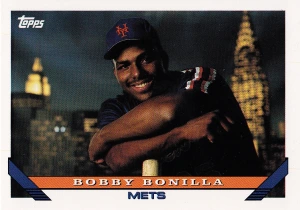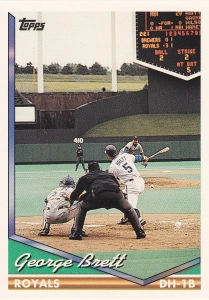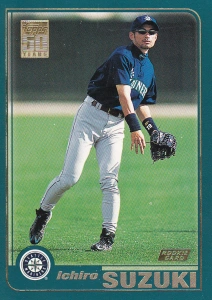I was 5 years old in 1985, and this is the first year I can remember anything from the sports world. I was in pre-school at the time – and I remember the buzz surrounding Pete Rose breaking the hit record. I don’t remember watching the game on TV – I think that would be one of those things where you’d remember exactly where you were (from a similar time frame, I do remember exactly where I was when the Challenger disaster occurred). But I remember the hype around it and hearing about it all over Cincinnati that summer. As I’ve said before, I don’t remember the Reds before Pete’s return, and 1985 was his first full year back.
Highlights and Events:
 Two Hall-of-Famers were traded to New York for prospects during the offseason. The A’s traded Rickey Henderson to the Bronx, while Montreal sent Gary Carter to the Mets. The trade for Carter was one of the last that solidified the team’s 1986 championship core. All-Star 1B Jack Clark was also traded – from the Giants to the Cardinals.
Two Hall-of-Famers were traded to New York for prospects during the offseason. The A’s traded Rickey Henderson to the Bronx, while Montreal sent Gary Carter to the Mets. The trade for Carter was one of the last that solidified the team’s 1986 championship core. All-Star 1B Jack Clark was also traded – from the Giants to the Cardinals.
The most notable story of the year was Dwight Gooden’s historic season. After winning the Rookie of the Year award and finishing 2nd in the Cy Young voting in 1984, Doc won the pitching triple crown (for the Majors, not just the National League) with a 24-4 record, 268 strikeouts and a 1.53 ERA. At one point he won 14 decisions in a row. His ERA is the lowest in a season since MLB lowered the pitching mound in 1969. Needless to say, “Doctor K” was a unanimous Cy Young Award winner, even though John Tudor of the Cardinals and Orel Hershiser for the Dodgers had seasons that would have won almost any other year.
 16 games into April, Yogi Berra was fired by the Yankees after a slow start and replaced by his own replacement, Billy Martin. Berra had become the 2nd player to manage his son (Dale) during those 16 games. This led to a decade-long feud with owner George Steinbrenner where Berra stayed away from Yankee Stadium, including the day dedicated to his former teammate in August. Phil Rizzuto was honored on “Phil Rizzuto Day” on August 4. This game was notable – the visiting White Sox were starting veteran Tom Seaver, who was sitting on 299 wins.
16 games into April, Yogi Berra was fired by the Yankees after a slow start and replaced by his own replacement, Billy Martin. Berra had become the 2nd player to manage his son (Dale) during those 16 games. This led to a decade-long feud with owner George Steinbrenner where Berra stayed away from Yankee Stadium, including the day dedicated to his former teammate in August. Phil Rizzuto was honored on “Phil Rizzuto Day” on August 4. This game was notable – the visiting White Sox were starting veteran Tom Seaver, who was sitting on 299 wins.
In July, the National League won yet another All-Star game in the Metrodome, their 13th in the last 14 tries. The first Home Run Derby took place the day before the game. The Derby was played in a 2-inning format where each player had 5 outs per inning (which allowed for potential ties). The American League outslugged the senior circuit 17-16, but Dave Parker (go Reds!) won the individual title, smashing 6 homers to outdistance five others who hit 4 each.
On August 6th and 7th, the players’ union walked out, the 6th work stoppage in MLB history. The stoppage was diverted when the owners agreed to increase the minimum player salary from $40k to $60k and make contributions to the pension fund.
There was some additional negative news that didn’t involve on-field play. The cocaine scandal of the 1980’s reached a crescendo during the Pittsburgh drug trials during September. Numerous notable MLB players were subpoenaed to testify before a grand jury, including former MVPs Parker, Keith Hernandez, and Vida Blue, who all admitted to using cocaine. 7 players were given 1-year suspensions that were revoked as long as they submitted to harsher testing and donated a portion of their salary to drug-related causes.
The trials were a particularly dark era for the Pirates franchise, and the longtime ownership headed by the Galbreath family was looking to sell the team. To keep the franchise in Pittsburgh, Mayor Richard Caliguiri organized a group of local businesses that bought the team (“Pittsburgh Associates”) until a long-term buyer could be found. This group owned the team for over a decade.
The Cincinnati Reds were also sold during the year – local auto dealership owner Marge Schott, who was a minority stakeholder at the time, purchased the controlling interest in the team for $11 million in December 1984, and was made CEO of the organization in 1985.
Milestones reached in 1985 included:
- Reggie Jackson passed 5 sluggers on the all-time home run list. Starting the year with 503 homers, Reggie hit 27 to pass Mel Ott (511), Ernie Banks, Eddie Mathews (512), Willie McCovey and Ted Williams (521). He’d finish the season 8th all-time, with 2 more greats in his reach for next year.
- On July 2nd, Joe Niekro won his 200th game, as the brothers Niekro joined their Perry counterparts as siblings with 200+ wins each.
- A few days later on July 11th, Nolan Ryan struck out Danny Heep to become the first pitcher to pass 4,000 K’s. People probably thought he was close to retiring…
- On August 4th, Rod Carew knocked a double off Frank Viola, earning his 3000th career hit against his former team, the Minnesota Twins. Carew was the 16th player to reach this milestone.
- Also on August 4th, Tom Seaver, who had played with Ryan almost 20 years earlier when the two started out with the Amazin’ Mets, stopped the Yankees on Phil Rizzuto day to pick up his 300th career win. Seaver was the 17th pitcher to accomplish this feat.
- Pete Rose finally realized his march toward Ty Cobb in September. On September 8th, as a late inning replacement at Wrigley Field, Rose knocked out 2 singles to tie Cobb’s career record of 4,191 hits. Subsequent research has shown that Cobb may have been actually credited with 2 extra hits, in which case, his first hit on this day would have been the record breaker. However, MLB still recognizes Cobb with 4,191 hits.
- Three days later, on September, Rose broke the record at home in front of a sold out Riverfront Stadium crowed with a single against San Diego’s Eric Show.
 The Yankees were involved in another 300th win. This time, Yankees pitcher Phil Niekro reached the milestone on October 6th, the final game of the year.
The Yankees were involved in another 300th win. This time, Yankees pitcher Phil Niekro reached the milestone on October 6th, the final game of the year.- Henderson’s debut season in pinstripes was one of the best ever as a lead-off hitter. He became the first player to hit 20+ home runs and steal 80+ bases (24/80), and was the first AL player with 20 / 50 (7 NL players had reached this feat).
- Darrell Evans of the Tigers led the majors in home runs with 40. He was the oldest HR champ in MLB history, and became the first player with a 40-homer season in both leagues (Mark McGwire has since accomplished this feat). Incidentally, his previous 40-homer season was in 1973 with the Braves, when he, Davey Johnson and Hank Aaron teamed as the only 40-HR trio in history.
Most of the division winners had solid 5+ game leads throughout all of September. The Blue Jays, led by another stellar season by ace Dave Stieb and sluggers Jesse Barfield and George Bell, outdistanced the Yankees in the AL East. The Dodgers had 4 starters with an ERA under 3, including Orel Hershiser who was 19-3 with a 2.03 ERA, and were never seriously threatened. The NL East was close throughout the year. The Mets lead the division as late as September 13th behind Doctor K. However, the Cardinals outdistanced the Mets in late September behind batting champ and MVP Willie McGee and the team’s league leading 314 base swipes, which was the most in the National League since the dead ball era. Rookie Vince Coleman accounted for 110 of those steals, setting a rookie record.
The closest race was in the AL West, where the Royals and Angels traded places throughout the year. The teams were tied going into October, but the Royals pulled out the division in the last week. Kansas City had a balanced team, again anchored by 3rd baseman George Brett, who finished 2nd in the MVP voting to Don Mattingly, and by youthful pitching staff headed by Cy Young winner Brett Saberhagen.
Rickey Henderson had passed Mike Schmidt as the best position players in baseball; Rickey was coming off 6 exceptional years in a row. He hit .315, walked 99 times, scored 146 runs, stole 80 bases and knocked out 24 homers en route to a slugging percentage over .500. Truly outstanding numbers for a leadoff hitter; he had an astounding 38 win shares in ’85, and probably deserved the MVP over his teammate Mattingly. Tim Raines had also likely passed Schmidt up at this point, and would be the best player in baseball by the next season (Henderson had good, but not great, campaigns in ’86 and ’87). If you wanted to exclude the great base-stealers and argue pure best hitter, Raines and Rickey would likely still be in the discussion, as would Dale Murphy, Cal Ripken and Wade Boggs.
Even though he had only two seasons under his belt, there was little doubt that Dwight Gooden was the best pitcher in baseball. His 1985 season was one of the best of the modern era. It’s probably the best season since baseball went to a 5-man rotation, probably ahead of those of Maddux, Pedro, and Randy Johnson later on. Add to that the fact that he was 2nd in the Cy Young voting the year before, and it’s hard to argue against him. If you look at performance over the past 3 and 5 year stints, Dan Quisenberry and Dave Stieb are definitely the best two, but I’d have to give it to Doc based on his pure dominance in his first 2 seasons.
Read on for the playoff summary…

































